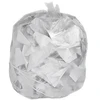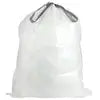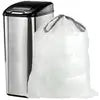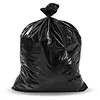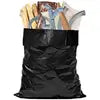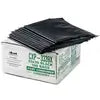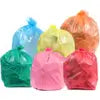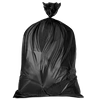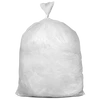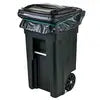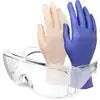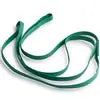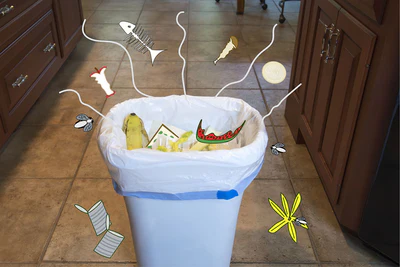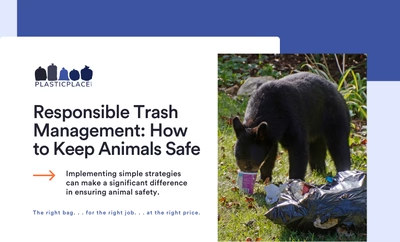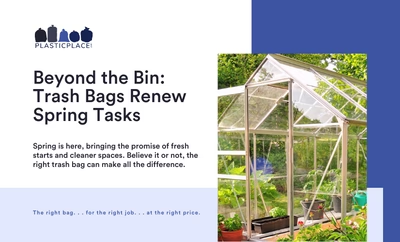So you want to buy trash bags. Sounds simple enough, right? Not really.
Standing in the trash bag aisle, you’ll soon find yourself bombarded with dozens of choices, all which seem pretty similar. You got your odor shield, odor block, odor lock. Then there's the litany of statements touting each bag’s strength: ultimate, extra strong, 3-ply strength, trusted strength.
Reading the product boxes won’t do you much good because they don’t have much in way of helpful information. Just hyped up claims.
So how do you choose the right trash bag? Good question.
The 2.4 Billion Dollar Trash Bag Question
The single most important question you must ask yourself before starting your search is: What is this trash bag going to be used for?
Kitchen waste? Lawn care? Recycling? Bathrooms? Office? The bag you need will depend on what you need the bag for. If you don’t answer this question, you’re literally throwing money away. You could end up wasting money on a more expensive, thicker bag when all you really needed was a less expensive, thinner bag or a shorter bag and thus wasting money on extra material.
Don’t think it’s such a valuable point to consider? Consider this: According to data from IRi for the 52 weeks ending April 21, 2013, for the foil, wrap and bag category, trash bags (including lawn and leaf bags) generated the most sales with $2.4 billion. That’s right…billion. With a “b.”
“While many consumers don’t give too much thought to which trash bag to purchase, manufacturers and retailers have thought extensively about it,” explains Michael Covitch, a Senior Fellow in the Research & Development department of the Lubrizol Corporation who holds a PhD in macromolecular science and has over 30 years of experience working with plastics. “There’s more technology in these simple products than anyone can imagine. At least being aware of potential differences between products can help consumer understand what they’re buying.”
OK. You’ve decided how you’re going use your trash bag. Great. Now, you need to think about if you need your trash bag to be strong resistant to punctures and tears, or be able to stretch under a big load. This factor will determine how thick/thin your trash bag needs to be. Here’s where you need to read the fine print on the product box.
Trash Bag Thickness
Trash bags thickness are usually measured in mil, which is one thousandth of an inch (.001). These type of trash bags are referred to as low density or linear low density.
Most trash bags you’ll find in the store will most likely range between .70 and .90 mil. You can find this measurement on the front of the box. Here’s an example:![]() If you’re purchasing a kitchen trash bag, and you’re putting in the standard trash fare of milk cartons, cereal boxes, leftovers, old fruit, etc., then a .90 mil bag will serve you just fine.
If you’re purchasing a kitchen trash bag, and you’re putting in the standard trash fare of milk cartons, cereal boxes, leftovers, old fruit, etc., then a .90 mil bag will serve you just fine.
However, if you’re cleaning out your garage or remodeling, you’ll need a bag that can stand up to punctures and tears from plaster, broken glass, hangers, nails, old paintings and the like. In that case, you want to look for a bag that is 2.0 mil or thicker like this 3.0 mil contractor bag:![]() StretchIf you need a bag that needs to stretch to carry a heavy load rather than survive punctures or tears, then a thinner bag will suit your needs much better. These types of bags are called high density and are the clear bags you often found in office restrooms. These bags are considerably less expensive than their thicker, low density cousin.
StretchIf you need a bag that needs to stretch to carry a heavy load rather than survive punctures or tears, then a thinner bag will suit your needs much better. These types of bags are called high density and are the clear bags you often found in office restrooms. These bags are considerably less expensive than their thicker, low density cousin.
If you’re throwing away paper or other light items, or have a large, heavy load with nothing that could rupture the bag, these high density bags will serve you and your pocketbook well.
Color
Although trash bags can be purchased in a rainbow of colors, black trash bags and white trash bags dominate the spectrum. White trash bags are a common choice because they blend in nicely with their surrounding and are not intrusive. Black trash bags help hide what’s in your bag and go well with stainless steel cans.Color also determines price. Black garbage bags are the least expensive since they can be made with the most recyclable material (our black trash bags, for example are made with over 90% recycled material). Next comes white and then clear.
Odor
There’s very little you can do about smelly trash, besides throwing it away. While many bags tout odor blocking features, they’re not going to put up much of a fight against spoiled cheese or fungus infested pasta salad. You’re better off dusting the inside of your trash bags with some inexpensive baking soda rather than spending the extra money.
Price
Surprisingly, price is not much of a factor when shopping for garbage bags. There’s not a great discrepancy between the prices of trash bags you’ll find in stores. Price really only becomes a factor if you’re purchasing in large quantities. Then, you’ll want to look at price per bag. Otherwise, it’s best not to choose a trash bag based on price. Spending the few extra cents to get a thicker, stronger bag may save you from spending time cleaning up that yogurt, coffee grounds and last night’s lasagna that escaped from a cheaper, thinner bag.
We All Need Closure
The final factor in your garbage bag quest will be what type of closure you prefer: drawstring, flap ties or the time-honored twist tie. Most people out there prefer the drawstring. It helps grip the can and makes for a quick, easy tie. Flap ties can be better for larger trash bags. Plus, they’re often less expensive than drawstring bags. And if you must have your twist ties, don't worry. You can include them for free when your order from us.
The Unknown Factor
After all the above factors have been considered, there’s one very obvious, but often overlooked factor that needs to be closely considered…your family. Does your child drag your trash bag over the drive way to the curb leaving a trail of trash so he can find his way back? Do you need to keep the local raccoons from having dinner at your house every night? Does your trash bag need to survive the two ton force of your husband’s size 12 shoe as he packs down the garbage to fit twice as much in? If your answer was “yes” to any of the above (or similar) questions, you may have to re-think your garbage purchase all together.But that’s another article…
 4.9 out of 5
4.9 out of 5 











